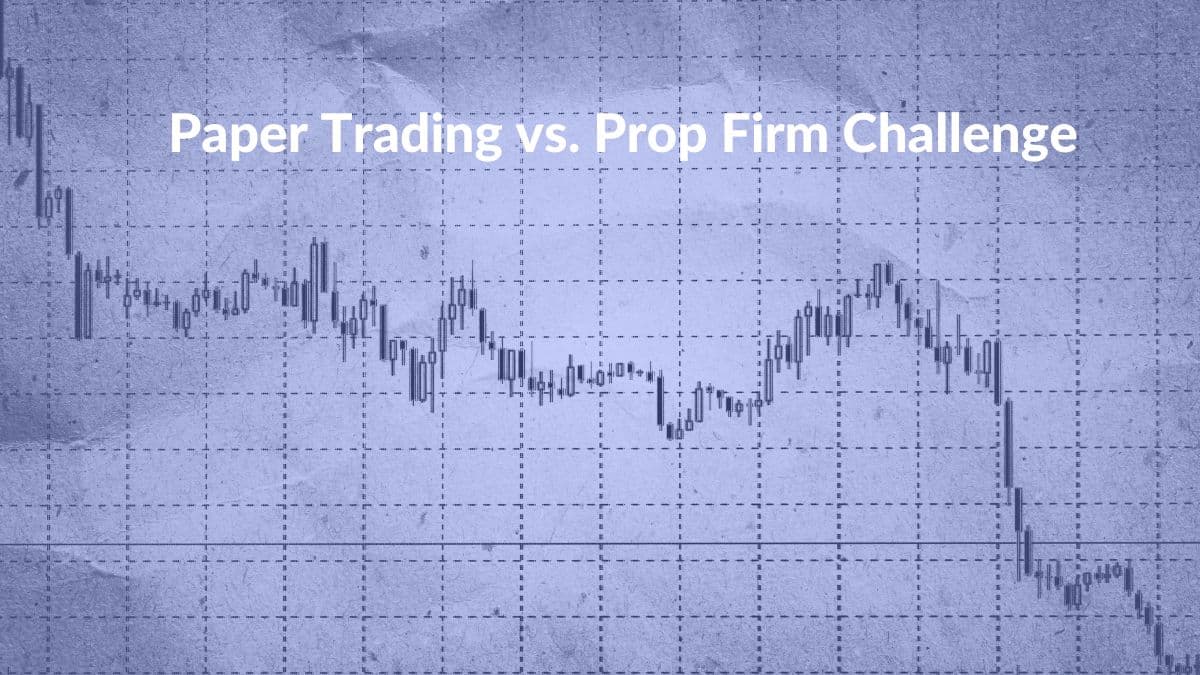Are you consistently hitting profit targets and feeling like a trading whiz on your demo account? Maybe you’re even thinking about taking the leap into the world of prop firms, dreaming of managing substantial capital and splitting profits. That’s fantastic ambition! But before you jump in headfirst, it’s crucial to understand a potentially harsh reality: demo account success often paints a misleading picture of your readiness for a real prop firm challenge.
Many aspiring traders find themselves in this exact situation. They excel in the simulated environment of paper trading, only to face unexpected hurdles and setbacks when they attempt to pass a prop firm’s evaluation. Why does this disconnect occur so frequently?
Prop firms offer an incredible opportunity: trade with their capital, prove your skills, and earn a cut of the profits. The appeal is undeniable. However, the transition from the seemingly comfortable world of demo trading to the pressure-cooker environment of a prop firm challenge is often where many aspiring traders stumble.
This article will dive into the key reasons why your demo account triumphs might not translate to prop firm challenge victories. We’ll explore the critical differences and offer actionable strategies to bridge this gap and better prepare you for the real deal. Let’s unpack why paper trading, while valuable, can be a deceptive indicator of your true trading prowess when real capital and performance expectations are on the line.
Lesson 1: The Psychological Reality Check – “Skin in the Game”
One of the most fundamental lessons many traders learn, often the hard way, is that “Paper trading is just not the same.” The core reason for this lies in one crucial element: risk.
In a demo account, the risk is entirely theoretical. You’re trading with play money. Losing trades? No real consequence. Winning trades? Feel good, but no tangible reward. This risk-free environment fundamentally alters your trading psychology.
Think about it:
- Fear of Loss is Absent: In demo trading, that gut-wrenching feeling of watching your hard-earned capital dwindle simply isn’t there. This can lead to overconfidence and overly risky trading behavior that you might never consider if real money were at stake. You might be tempted to “experiment” with strategies you wouldn’t dare try with your own funds.
- Discipline Lags: Sticking to a strict trading plan and risk management rules is easier said than done, even in the best of times. But in a demo account, the incentive to be disciplined is weaker. If you deviate from your plan and it backfires? Just reset the demo account and start again.
- Emotional Disconnect: Trading isn’t purely logical; emotions play a huge role. Paper trading, by its very nature, minimizes emotional engagement. You’re less likely to feel the anxiety of a losing streak or the greed that can tempt you to over-leverage.
Now, contrast this with a prop firm challenge. Suddenly, there is skin in the game. Even if it’s just the initial challenge fee you paid, there’s a tangible loss on the line. More importantly, you’re trading for the opportunity to manage real capital and earn a profit split. This shift flips the psychological switch.
Emotions become amplified:
- Fear of Failure: The pressure to pass the challenge and prove yourself can be intense. This fear can lead to hesitant trading, analysis paralysis, and missed opportunities.
- Fear of Drawdown: Prop firms have strict drawdown limits. Every losing trade brings you closer to breaching those limits and failing the challenge. This constant awareness can induce anxiety and lead to overly conservative trading or, conversely, panic-driven mistakes.
- Pressure to Perform: Profit targets and time constraints create a sense of urgency. You might feel compelled to force trades, even if setups aren’t ideal, just to meet the requirements within the timeframe.
In short, your demo account success might be built on a foundation of psychological detachment that crumbles under the weight of real-world trading pressures.
Lesson 2: The Prop Firm Pressure Cooker – It’s More Than Just Strategy

It’s tempting to think that if you have a winning trading strategy, you’re set for prop firm success. While a solid strategy is essential, it’s only one piece of the puzzle. Prop firm challenges introduce a unique set of external pressures that go far beyond simply executing your strategy. It’s like trading in a pressure cooker.
Prop firm challenges are structured with specific performance metrics and rules designed to test not just your strategy, but your discipline and emotional resilience under pressure. These rules, while necessary for the prop firm to manage risk, can significantly impact trader psychology:
- Profit Targets: The clock is ticking to reach a pre-defined profit percentage. This can create a sense of urgency, pushing traders to take on trades that are outside their usual strategy, simply to chase those targets. “Just a few more pips to go!” can become a dangerous mantra leading to impulsive decisions.
- Drawdown Limits (Daily & Maximum): The fear of breaching drawdown limits looms large. Knowing you have a limited buffer before failing can make you overly cautious, causing you to miss valid entries or exit winning trades prematurely to “lock in profits” and avoid drawdown. Conversely, it can also trigger desperate, high-risk attempts to recover losses quickly.
- Time Constraints: Challenge durations are limited. This time pressure can exacerbate the urge to force trades. You might feel compelled to trade even when market conditions aren’t favorable, just to show activity and progress within the allotted time.
- Minimum Trading Days/Consistency Rules: Some firms require trading on a minimum number of days, or have rules about consistent performance. While intended to encourage disciplined trading, these rules can also add pressure to trade even when your strategy isn’t signaling clear opportunities.
These performance metrics, while seemingly objective, create a high-stakes environment that is completely absent in paper trading. In the demo world, you can trade at your leisure, with no deadlines, no profit targets hanging over your head, and no fear of immediate account termination for losses. This pressure-free environment allows for a different, often less realistic, style of trading.
Lesson 3: Subtle Market Differences – Demo vs. Real Market Conditions
While demo accounts are invaluable tools for strategy testing and practice, it’s important to recognize that they are, at their core, simulations. They strive to replicate real market conditions, but subtle differences can exist, and these nuances can contribute to the gap between demo success and live challenge performance.
Here’s where demo accounts can sometimes fall short in perfectly mirroring real-world trading:
- Order Execution & Slippage: In the fast-paced world of trading, especially in volatile markets, the price you see on your screen when you click “buy” or “sell” isn’t always the price you get. This difference is called slippage. Real markets experience slippage, particularly during periods of high volatility or low liquidity. Demo accounts often minimize or even eliminate slippage to provide a smoother, more user-friendly experience. However, in live trading, slippage is a reality that can eat into your profits and widen your losses. Order execution speed can also be slightly different in live accounts compared to demos, especially depending on your broker and connection.
- Liquidity & Volatility Replication: Demo accounts strive to simulate market liquidity and volatility, but they are still simplified models. Real market liquidity fluctuates constantly, and volatility can spike unpredictably, especially around major news events. Demo environments might not always perfectly capture these rapid shifts in market dynamics. This can be particularly relevant for strategies that rely on precise execution at specific price levels or during high-volatility periods.
- Broker Spreads & Commissions: The spread is the difference between the buying and selling price of an asset, and commissions are fees charged per trade. These trading costs directly impact your profitability. Demo accounts may use fixed or idealized spreads, making it easier to achieve profitability in the simulated environment. Real prop firm accounts, however, will have variable spreads that widen and narrow based on market conditions, and commissions may be applied. These real-world trading costs can reduce your net profits and affect the viability of certain strategies, especially those with tight profit targets.
- Data Feed Nuances: While less common now with advanced demo platforms, subtle differences in data feeds between demo and live accounts can sometimes exist. These discrepancies, though often minor, could potentially affect the precision of technical indicators or price action patterns, especially for very short-term trading styles.
While each of these individual differences might seem small in isolation, their cumulative effect over numerous trades can be significant. For traders employing scalping strategies or those relying on extremely precise entry and exit points, these subtle market realities can contribute to the divergence between demo and live trading outcomes.
Bridging the Gap: Actionable Strategies to Prepare for Prop Firm Challenges
So, demo account success isn’t a guaranteed ticket to prop firm funding. But don’t despair! Paper trading is still a valuable tool. The key is to understand its limitations and proactively bridge the gap between the demo environment and the real pressures of a prop firm challenge. Here’s how:
- Transition from Demo to Realistic Practice:
- Treat Your Demo Account Like Real Money: This is paramount. Psychologically “commit” to your demo account as if it were funded with your own capital.
- Set Realistic Risk Parameters: Define your risk per trade and daily/weekly loss limits, just as you would for a real account. Stick to these limits religiously in your demo trading.
- Strictly Adhere to Your Trading Plan: Don’t deviate from your strategy, even in demo. Practice discipline and consistency.
- Journal Your Demo Trades and Emotions: Track not just your trades, but also your emotional state during trading. Identify triggers for emotional trading and work on managing them.
- Consider a Micro-Account “Stepping Stone”: Before jumping into a full prop firm challenge, if feasible, open a micro-account with a small amount of your own capital. Trading with even a small amount of real money will expose you to the psychological realities of live trading in a way that demo accounts simply cannot.
- Treat Your Demo Account Like Real Money: This is paramount. Psychologically “commit” to your demo account as if it were funded with your own capital.
- Focus on Process and Risk Management, Not Just Profit:
- Shift Your Mindset: Reframe your goal for the prop firm challenge. Instead of solely focusing on the profit target, prioritize consistent execution of your strategy and impeccable risk management. Passing the challenge will be a result of good process, not the primary objective itself.
- Develop a Robust Risk Management Plan (and Stick To It!): This is non-negotiable for prop firm success. Your plan should include:
- Position Sizing Rules: Determine exactly how much capital you will risk on each trade, based on your account size and risk tolerance.
- Stop-Loss Strategies: Pre-define your stop-loss levels before entering any trade and always use them.
- Drawdown Management Tactics: Have a plan for how you will react if you experience a drawdown. Will you reduce position size? Take a break? Re-evaluate your strategy?
- Mindset and Emotional Training are Crucial:
- Acknowledge the Psychological Game: Trading, especially under pressure, is heavily influenced by psychology. Recognize that emotions will arise during a prop firm challenge.
- Incorporate Emotional Control Techniques:
- Mindfulness and Meditation: Practice mindfulness or meditation techniques to improve your ability to stay calm and focused under pressure. Even short daily sessions can make a difference.
- Trading Journal for Emotional Awareness: Use your trading journal to specifically track your emotional state before, during, and after trades. Identify emotional patterns and triggers that lead to mistakes.
- Stress Management Strategies: Develop healthy coping mechanisms for stress outside of trading. Exercise, proper sleep, and breaks from screens are essential.
- Refine Your Strategy with Realistic Expectations:
- Backtest and Forward Test Thoroughly: Don’t rely solely on demo account results. Backtest your strategy on historical data to understand its performance characteristics and potential drawdowns. Continue forward testing in your realistic demo environment (treating it like real money) for a significant period before attempting a live challenge.
- Understand Strategy Limitations: No trading strategy is foolproof. Accept that losing trades are part of the process. Focus on having a strategy with a statistical edge over the long run, rather than chasing perfection or trying to avoid all losses.
Conclusion
Demo account success is a valuable starting point on your trading journey, providing a sandbox to learn the mechanics of trading and test strategies. However, it’s vital to recognize that demo profits alone are not a reliable predictor of your ability to conquer a prop firm challenge. The psychological pressures of real money, performance metrics, and subtle market realities create a completely different trading environment.
To truly bridge the gap and prepare for prop firm success, you must move beyond simply executing strategies in a risk-free demo world. Focus on developing robust risk management, cultivating emotional discipline, and practicing in a realistic demo environment where you treat every trade as if real capital were on the line.
The prop firm path offers incredible opportunities, but it demands more than just a profitable strategy on paper. It requires mental fortitude, disciplined execution, and a realistic understanding of the psychological and practical differences between demo and live trading.
Author
-
Alex started his career creating travel content for Jalan2.com, an Indonesian tourism forum. He later worked as a web search evaluator for Microsoft Bing and Google, where he spent over a decade analyzing search relevance and understanding how algorithms interpret content. After the pandemic disrupted online evaluation work in 2020, he shifted to freelance copywriting and gradually moved into SEO. He currently focuses on content strategy and SEO for finance and trading-related websites.
Recent Posts






